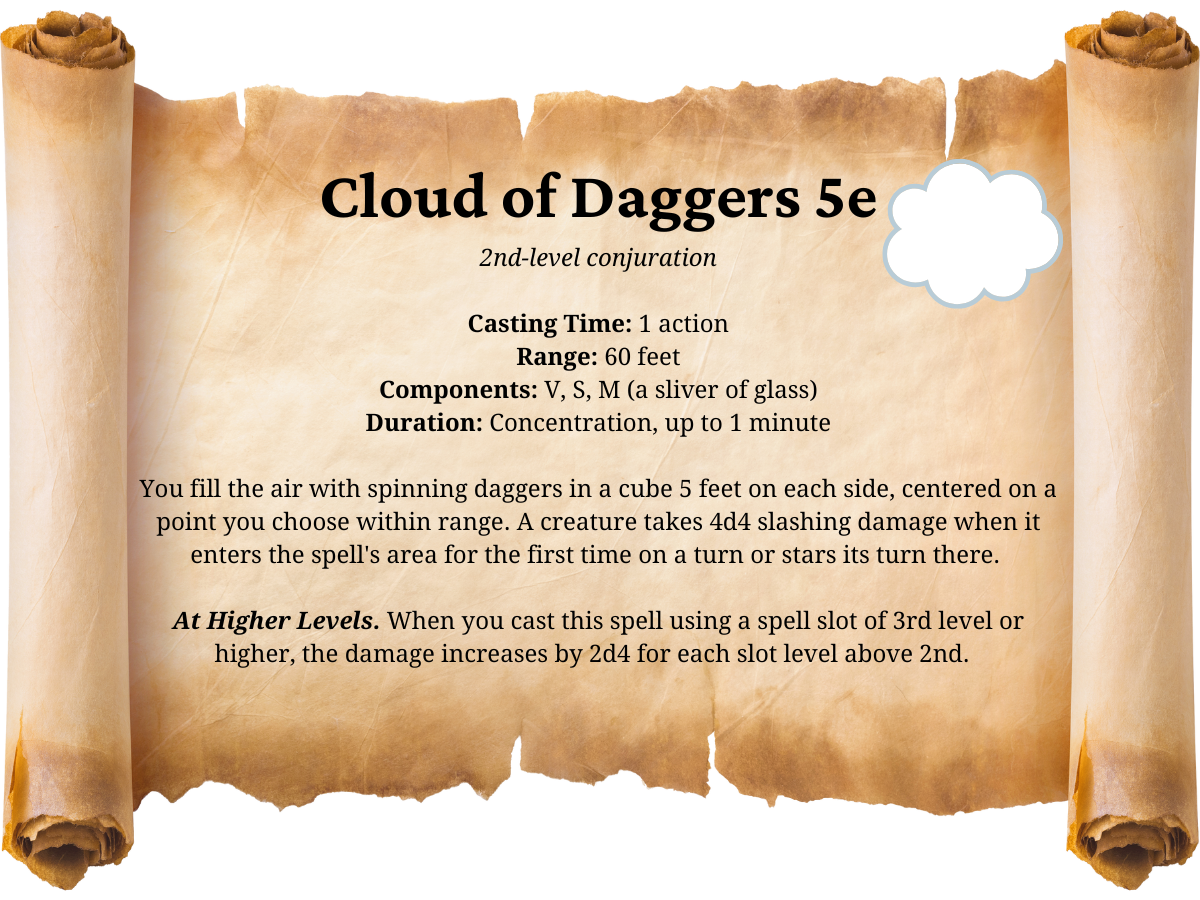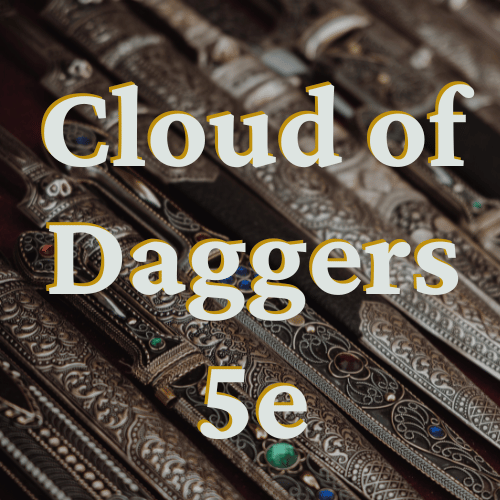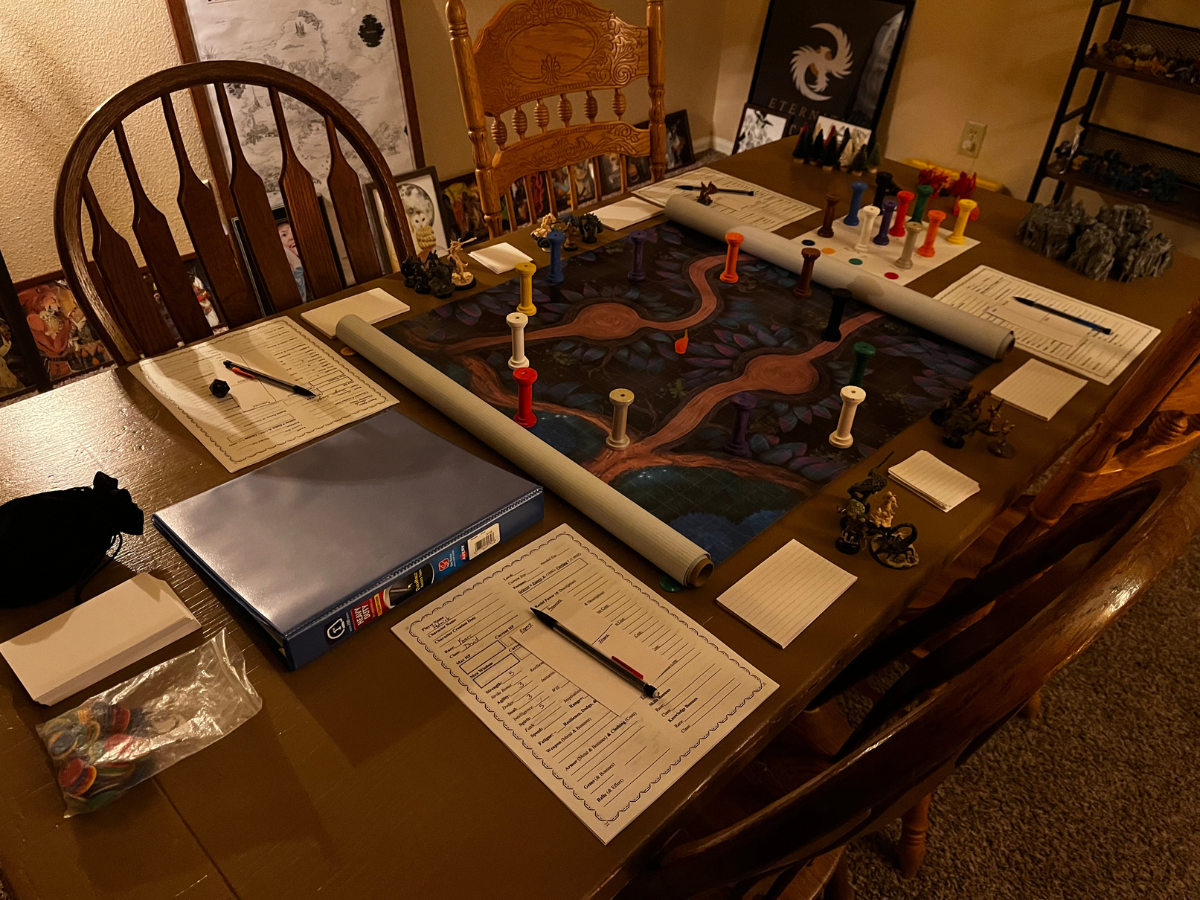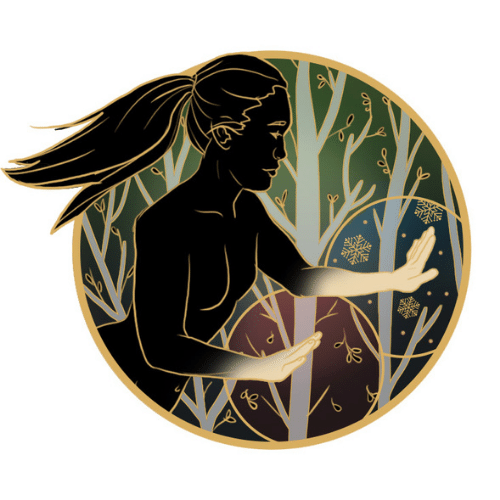Cloud of Daggers - D&D 5th Edition Spell Book

Cloud of Daggers Spell Effects
2nd-level conjuration
Casting Time: 1 action
Range: 60 feet
Components: V, S, M (a sliver of glass)
Duration: Concentration, up to 1 minute
You fill the air with spinning daggers in a cube 5 feet on each side, centered on a point you choose within range. A creature takes 4d4 slashing damage when it enters the spell's area for the first time on a turn or stars its turn there.
At Higher Levels. When you cast this spell using a spell slot of 3rd level or higher, the damage increases by 2d4 for each slot level above 2nd.
All information on Cloud of Daggers comes from the DnD Player's Handbook.

Classes That Can Cast Cloud of Daggers
The following classes from the player's handbook can cast cloud of daggers:
- Bard
- Sorcerer
- Warlock
- Wizard
Cloud of daggers is honestly a pretty strange spell. As you'll see below, it's not very powerful (nor does it make a lot of sense, in my personal opinion). Cloud of daggers seems more like something a bard player came up with one time, and then the spell somehow made it into the official game.
Otherwise, it's a little hard to imagine why any spell caster would create a literal cloud of what I imagine to be spinning daggers.
Cloud of Daggers Spell Effectiveness
| Damage | 2nd-Level Spell | 3rd-Level Spell | 4th-Level Spell | 5th-Level Spell | 6th-Level Spell | 7th-Level Spell | 8th-Level Spell | 9th-Level Spell |
|---|---|---|---|---|---|---|---|---|
| Damage Dice | 4d4 | 6d4 | 8d4 | 10d4 | 12d4 | 14d4 | 16d4 | 18d4 |
| Average Damage | 10 | 15 | 20 | 25 | 30 | 35 | 40 | 45 |
| 3-Target Damage from Burning Hands | 42 | 52 | 63 | 73 | 84 | 94 | 105 | 115 |
| Average Fighter DPR | 15 | 19 | 23 | 27 | 30.5 | 34 | 37.5 | 41 |
Spell Damage
The table above compares cloud of daggers to burning hands 5e, a 1st-level evocation spell, and to a fighter's average damage per round. The biggest thing to note here is that cloud of daggers is not a ranged spell attack, and it doesn't require a saving throw. Instead, if a target begins their turn in the affected area, or moves through it, they automatically take damage. So, though the damage represented in the table above appears quite low comparatively, burning hands and the fighter's represented damage are calculated without factoring in hit chance, so their true values would be quite a bit lower in some cases.
Cloud of Daggers Usefulness
Cloud of daggers basically has two features that make it useful:
- The spell does not require a hit chance. Since it's neither a ranged spell attack nor requires a saving throw, when you cast the spell on a target, when that target begins their next turn, they automatically take damage.
- Furthermore, the spell can be maintained with concentration, meaning that you can cast the spell at a choke point, forcing enemies to walk through your cloud of daggers to get to you. If there is no such 5-foot sq. choke point in your environment, however, then this additional advantage disappears.
Since Cloud of Daggers does not require any kind of hit chance, you should cast the spell on enemies who:
- Have very high AC and are therefore resistant to spells such as chromatic orb and chill touch 5e.
- Have very high Dexterity saves and are therefore resistant to spells such as burning hands, call lightning 5e, and even cantrips like acid splash 5e.
If there happens to be a choke point on the battlefield such as a 5-foot wide tunnel, or perhaps a 5-foot wide bridge that enemies have to cross, cloud of daggers could actually be an amazing spell choice. If you can center cloud of daggers on an enemy, dealing damage, and then force others to either not pass through the cloud of daggers at all, or push past and take more automatic damage, then the spell could really shine.
Honestly, if you had some choke point with an area you were trying to defend for 1-minute or less (the spell's duration), cloud of daggers could actually work like an improved alarm 5e, as not only would you be alerted to enemies crossing through - via their screams of pain - but yes, you would also deal damage with your alert system.
Slashing Damage Resistances, Immunities, and Vulnerabilities
In the D&D monster manual there are 6-monsters with slashing damage resistance, only 2-monsters with slashing damage immunity, and 0-monsters with slashing damage vulnerability. Of all the damage types, slashing damage is one of the least resisted, and is pretty much secure as a good spell damage choice almost no matter what you're facing.

Combine Cloud of Daggers with the Following Spells
Most DnD spells have some kind of other spell type that they mix well with, whether they increase hit chance, give more actions, or increase defenses, etc. With cloud of daggers, I wouldn't really say that there are many directly beneficial support spells, though I suppose that there are a few that could work well together.
- Banishment 5e: say that you've cast banishment on an extra-planar enemy. Once the 1-minute spell effect from banishment is up, that being will be banished from your current plane for good - or that is, at least until they find a way back. In any case, if you can use cloud of daggers to protect an ally while they concentrate on banishment, this combination could make for a very successful combat encounter.
- Blindness Deafness 5e: this is a pretty mean combination, but imagine blinding an enemy, then casting cloud of daggers right in front of them. Since they're blind, chances are high that they could walk right into your spell. Of course, you could always just cast cloud of daggers right in their space to begin with, so blinding them isn't really necessary. But I imagine that being slashed by a cloud of daggers while blinded would be significantly more terrifying than the spell's usual effect.
- Cause Fear 5e: if your goal is to prevent enemies from attacking you - say especially if you have a choke point with cloud of daggers set up - then a spell like cause fear could also be helpful to use, especially against any ranged characters who wouldn't need to pass through cloud of daggers in order to attack you. Note, however, that since cloud of daggers in also a concentration spell, you'd need to coordinate cause fear with one of your other party members.
- Charm Person 5e: similar to cause fear, you could charm enemies with enough range or spells to avoid cloud of daggers.
- Spiritual Weapon 5e: since spiritual weapon can be moved away from you, and is immune to damage, you could cast cloud of daggers, then send your spiritual weapon after your enemies, beyond the choke point. Spiritual weapon is also a concentration spell, however, so an ally would need to cast this spell.
Cloud of Daggers Counters
So many spell effects are more or less nullified by the fact that cloud of daggers doesn't require a ranged spell attack or even a saving throw. However, as always, silence 5e is a nice choice to prevent the spell from ever being cast, in the first place. If you're charging into a choke point and you're facing a bard, sorcerer, warlock, or wizard, you can be sure that they're thinking about cutting off the choke point with cloud of daggers, so silencing them ahead of time could be a great move.
Additionally, the relatively useless cantrip blade ward 5e actually has some great value against cloud of daggers as it grants you resistant to slashing damage for 1-round. If you need to charge through a choke point that's covered by cloud of daggers, cast blade ward and run in. You'll certainly find yourself far better off than if you'd run through without the slashing damage resistance, that way.
Cloud of Dagger-Type Spells in Eternity TTRPG
Finally, I'll share a bit about the Eternity TTRPG Game System. I realize that you came here for information on cloud of daggers, but maybe you've been thinking about checking out other TTRPG systems. If that's the case, then I'll keep it short: Eternity TTRPG allows for multiple players to act as the game master at various times during your campaign. The game also features very fast-paced combat encounters, and every class/ character feels like it has something meaningful to contribute, while also being equally useful.
Below, I've included a sample spell for you that somewhat represents the general purpose of cloud of daggers. You can take a quick look to see if you like the game's flavor. If so, there are links below for where you can find the game.

Chaosmancer - Core Class Spell
Gravity (Magic): 8Range, creates a “Gravity” space that remains for Battle Duration. Every turn, up to 3 enemies in 8Range of the “Gravity” space, -3Faith vs. Resilience, all affected targets are either pulled up to your Range+ value towards the “Gravity” space, or pushed up to your Range+ value away from the “Gravity” space, at your choice.
You can only have one “Gravity” space active at a time. You can instead choose to continually maintain this Spell for 3Inspiration, making it an Instant Action at the start of every Battle.
(Double-Hit): pulled or pushed your Range+ value +4. *Double-Hit can only affect one target, per turn.
(Dazed): the effect from “Gravity” is temporarily interrupted while you are Dazed.
- (Chaos Stream) If this spell hits, affected targets also have -3Initiative for 1turn. You can instead choose to continually maintain this Critical for 2Intelligence (plus the base 3Inspiration, and 0Wisdom), making it an Instant Action at the start of every Battle.
- (Mirror Star) Whenever an enemy is pulled into the “Gravity” space, -10Faith vs. Will, deals 1damage. This Critical cannot Double-Hit or give a Block. You can instead choose to continually maintain this Critical for 2Intelligence (plus the base 3Inspiration, and 0Wisdom), making it an Instant Action at the start of every Battle.
- (Celestial Energies) Instant Action. When you use this Critical, you can’t use any more Wisdom this turn.
Though cloud of daggers is aesthetically far away from creating a point of gravity on the map, functionally, they have similarities. Gravity pulls (or pushes) enemies away from you, and the "Mirror Star" Critical option allows you the chance to deal damage whenever enemies are pulled into the point of gravity. Overall, it's an effective way - choke point or not - to protect yourself, positionally, from enemies.
Curious to learn more about the Eternity TTRPG Game System? Check out the
Eternity TTRPG Core Game PDF!
Dice, Dungeons, Games & More - Eternity TTRPG
Share This Article

Author - Jacob Tegtman
Dear reader, I hope you enjoyed this article. Tabletop gaming has been a passion of mine since I was 6 years old. I've played just about every game from Dungeons and Dragons to video games like Final Fantasy. These games have inspired me, made me laugh, made me cry, and brought me endless hours of enjoyment.
I started Eternity TTRPG - and the indie tabletop game that goes along with it (Eternity Shop) - to share my love of gaming with others. I believe that in our technology-driven age, tabletop games help bring a sense of magic and community back into our world.
If you love the site, please share it with others! I have lots of gaming-related material for you to peruse and use in your own gaming sessions. If you have any questions about the site or want to contribute, just send me a message using the "Contact" page, which you can find in the site's footer.










